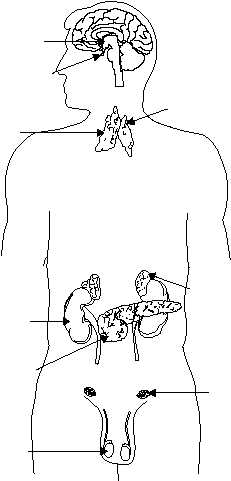gland to stimulate the release of its hormones and to
help regulate body temperature (fig. 1-47).
PITUITARY GLAND
The pituitary is a small, pea-sized gland located at
the base of the brain in the sella turcica, the
saddle-shape depression of the sphenoid bone
(fig. 1-47). It is often called the master gland of the
body because it influences many other endocrine
glands. Although the pituitary looks like just one
gland, it actually consists of two separate glands, the
anterior pituitary gland and the posterior pituitary
gland.
Anterior Pituitary Gland
The anterior pituitary gland plays the more
important role in influencing body functions. The
hormones produced by the anterior pituitary gland
have a broad and significant range of effects.
SOMATOTROPIN.—Somatotropin, the growth
hormone, influences body growth and development.
During the growth years, an overproduction of
somatotropin causes giantism, while the lack of it
causes dwarfism. An overproduction after the growth
years causes acromegaly, which is characterized by
the development of abnormally large hands, feet, and
jaw.
T H Y R O T R O P I N . — T h y r o t r o p i n , o r t h e
thyroid-stimulating hormone (TSH), influences the
growth, development, and secreting activities of the
thyroid gland.
GONADOTROPIN.—Gonadotropin influences
the gonads and is essential for the normal development
and functioning of both male and female reproductive
systems.
A D R E N O C O R T I C O T R O P I N . — T h e
adrenocorticotropin hormone (ACTH) acts primarily
on the adrenal cortex (the outer portion of the adrenal
glands), stimulating its growth and its secretion of
corticosteroids. Corticosteroid hormones affect every
cell in the body and are discussed in more detail later in
this section.
Posterior Pituitary Gland
The posterior pituitary gland produces two
hormones, antidiuretic hormone (ADH) and oxytocin.
A N T I D I U R E T I C . — T h e A D H h o r m o n e ,
promotes the conservation of water by the kidney.
When ADH is not produced in adequate amounts, the
daily urine volume is between 10 and 15 liters instead
of the normal 1.5 liters. This condition is known as
diabetes insipidus.
OXYTOCIN.—Oxytocin stimulates contraction
of the muscles of the uterus, particularly during
pregnancy. It also plays an important role in the
production of milk in the mammary glands of nursing
mothers.
THYROID GLAND
The thyroid gland, shaped like a butterfly, lies in
the anterior part of the neck, below the larynx
(fig. 1-47). It consists of two lobes, one on each side of
the upper trachea, connected by a strip of tissue called
the isthmus. The thyroid secretes the iodine containing
hormone thyroxin, which controls the rate of cell
metabolism. Excessive secretion of thyroxin raises the
metabolic rate and causes hyperthyroidism. This
condition is characterized by a fast pulse rate,
dizziness, increased basal metabolism, profuse
sweating, tremors, nervousness, and a tremendous
appetite coupled with a loss of weight.
1-42
HM3F0147
HYPOTHALAMUS
PITUITARY
GLAND
PARATHYROID
GLAND
THYROID
GLAND
KIDNEY
PANCREAS
ADRENAL
GLAND
OVARY
(IN FEMALE)
TESTIS
(IN MALE)
Figure 1-47.—Major endocrine glands.


